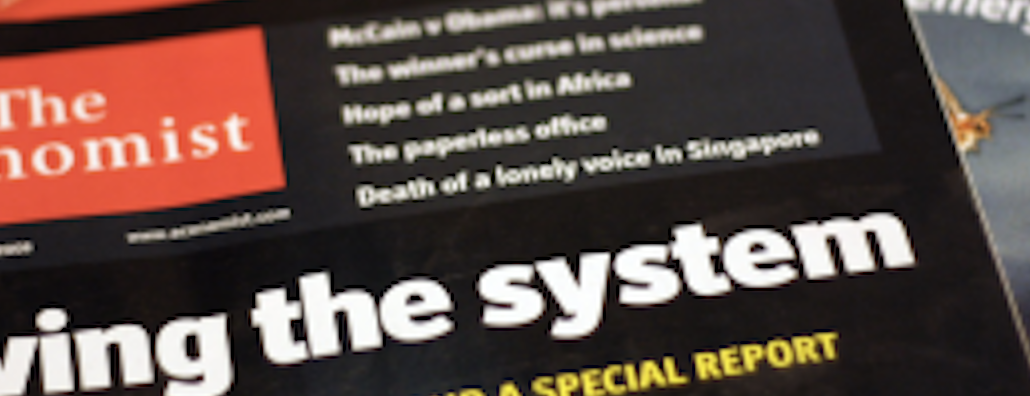Save 50% on a 3-month Digiday+ membership. Ends Dec 5.

At a time when there are few profitable bright spots in the print publishing universe, The Economist shines. The British magazine has an ambitious goal: to double circulation profits in the next five years, said Michael Brunt, CMO and managing director of circulation.
The Economist Group reported a total revenue of nearly £330 million ($473 million) at the end of 2015, with profit margins between 18 and 20 percent for the last five years. The recent ABC figures show that in the last year, the global digital circulation for The Economist has grown by 30.8 percent to just over 303,500. Its readership is tiny, and it’s miles away from reaching saturation point.
To keep growing, The Economist needs to increase its digital subscribers, reduce the cost of print by migrating subscribers to digital, and reduce cost per customer acquisition.
It’s on track to reach its targets, said Douglas McCabe, CEO of media analyst Enders, who points out that this growth is pretty achievable and that The Economist “has successfully transitioned from print to digital as few publications have done.”
Brunt explains The Economist is at 3 percent penetration in the U.K., having identified 132 million people who are potential readers of The Economist. There is overseas growth potential too. It’s looking east to Asia, where it’s only at 0.2 percent penetration, and is exploring distribution tactics through popular Japanese messaging app Line and a bilingual app for Chinese users. Its biggest market is the U.S., where it still has only 1.5 percent penetration.
By migrating from print to online subscriptions, it’s already saving on print and distribution costs. It has also saved by cutting 100,000 bulk print sample copies that would originally have been gratis in high-end hotels or on flight. Still, McCabe does concede that the culling of the bulk copies could have a detrimental effect on advertising income, which would need to be mitigated.
New pricing of its subscription products is helping it drive profitability too. The Economist unbundled its subscription offers and then rebundled them, charging 25 percent more for readers who buy the print and digital subscription. Two-thirds of new subscribers choose to take the print and digital offer (for £46, or $66.34, per quarter); out of the remaining third, it’s split half and half of readers who choose to take out either the print or digital subs (for £38, or $54.80, per quarter).
Ad position: web_incontent_pos1
Globally, there are just under 1.3 million print subscribers, so there’s still opportunity for migrating print readers to digital too. But The Economist remains wary of news aggregators, like Apple News. Because penetration is currently so small, it provides an opportunity for reach, rather than cannibalizing subscriptions, but it may not be this way forever.
The Economist has been able to lower cost of acquiring each new digital subscriber by half over two years through more cost-effective targeted advertising. This is largely through work that it has done with agency Proximity, where it reached over 200 million people through ads mostly bought programmatically. Users were retargeted and eventually hit with a commercial message, leading to thousands more subscribers.
According to Brunt, its declining print revenues have been offset by the money brought in by its thought-leadership series, The Economist’s branded content arm, which has earned respect for work that it has done with GE, among others. This has helped it to maintain premium advertising rates, while most publishers experience downward pressure.
As part of a paywall 2.0 strategy, The Economist has a number of paid-for digital products that help drive revenue from those who don’t want to pay for the full subscription. Its daily news app Espresso (for £2.29, or $3.30, a month) has 1.1 million downloads, according to the publisher, and 200,000 weekly readers, 40 percent of Economist subscribers access Espresso. This has clear consumer value, said McCabe, “a world in which short-form communications dominate discourse.”
More in Media

What publishers are wishing for this holiday season: End AI scraping and determine AI-powered audience value
Publishers want a fair, structured, regulated AI environment and they also want to define what the next decade of audience metrics looks like.

Digiday+ Research Subscription Index 2025: Subscription strategies from Bloomberg, The New York Times, Vox and others
Digiday’s third annual Subscription Index examines and measures publishers’ subscription strategies to identify common approaches and key tactics among Bloomberg, The New York Times, Vox and others.

From lawsuits to lobbying: How publishers are fighting AI
We may be closing out 2025, but publishers aren’t retreating from the battle of AI search — some are escalating it, and they expect the fight to stretch deep into 2026.
Ad position: web_bfu